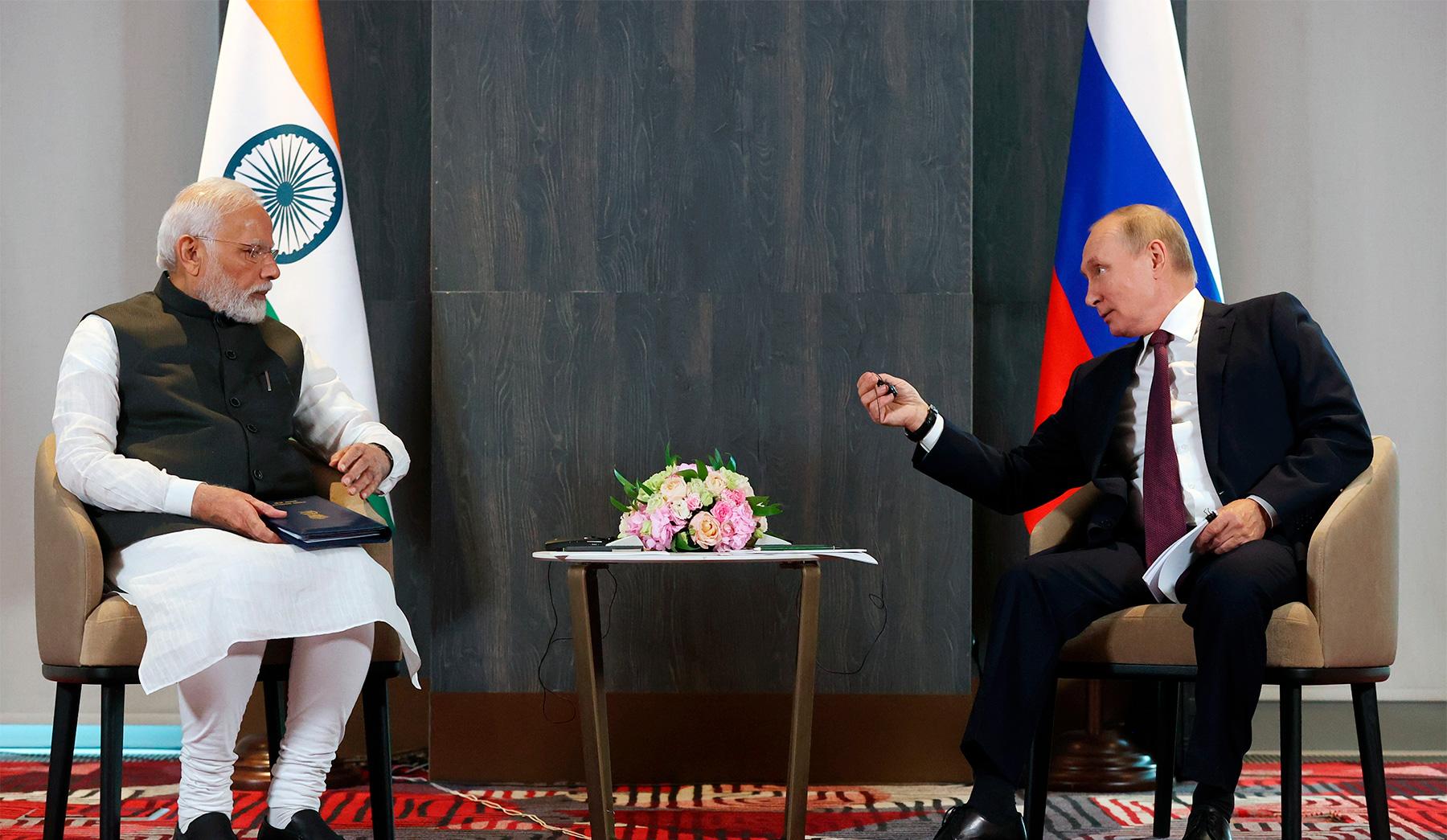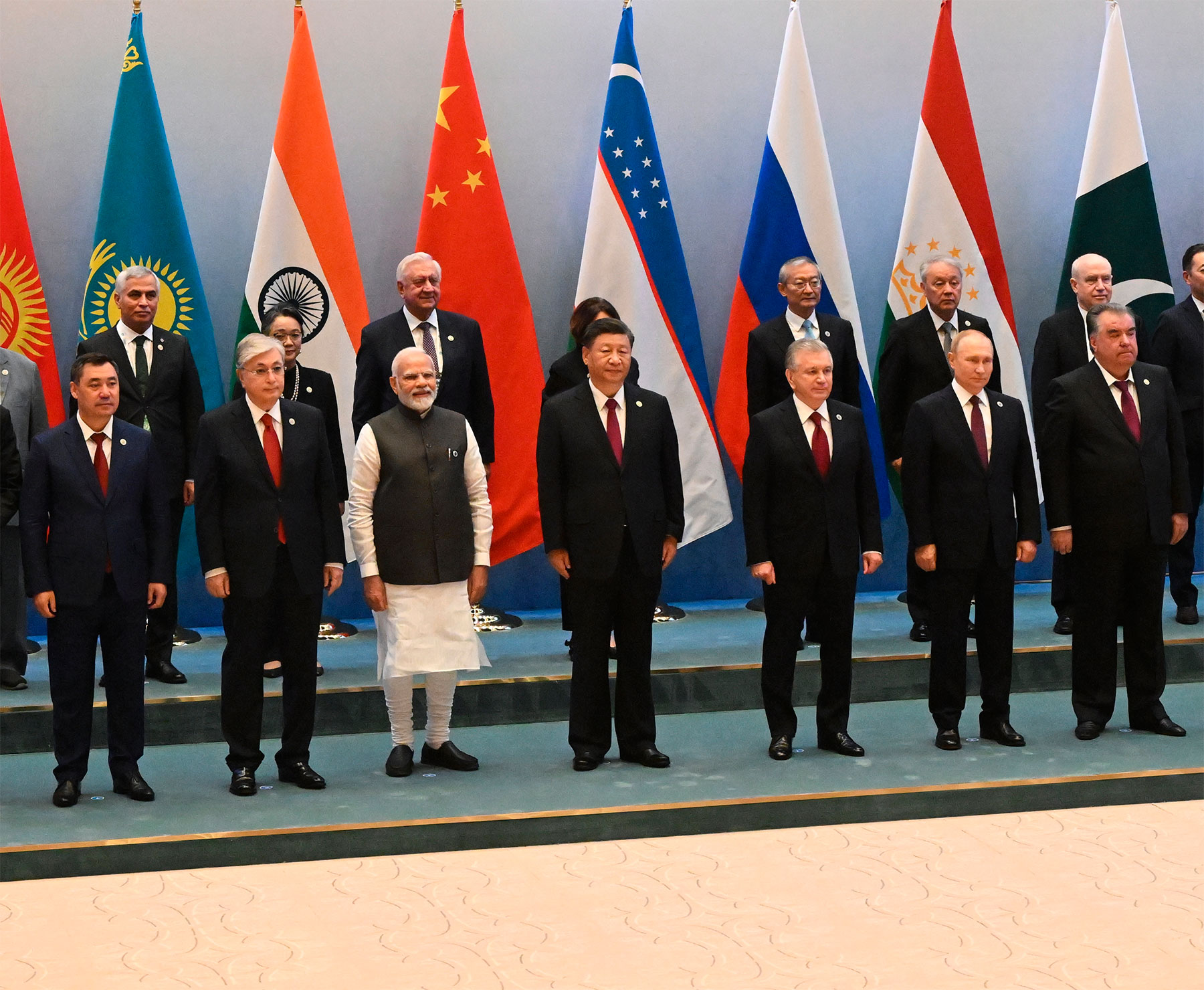Is Russia losing India? They raise this question at practically every conference, workshop or an expert meeting on Russian-Indian relations since the times of the Soviet disintegration in early 1990s. Quite often, the predominant views expressed by participants are pessimistic, if not alarmist.
Of course, the mere fact that we keep talking about “Russia losing India” for thirty years suggests that such conclusions are at least premature and one-sided. However, it is hardly possible to simply dismiss the gloomy predictions as groundless and untenable.
Indeed, positions taken by Moscow and New Delhi on many of the important Eurasia and global issues—from Ukraine to Afghanistan, from “One Belt, One Road” to Quad and to the concept of Indo-Pacific are not identical, which sometimes leads to suspicion and the erosion of mutual trust that has always been a solid foundation of the bilateral relations. In 2020 and in 2022 Russia and India did not even hold their traditional annual summits and it is not clear when President Vladimir Putin and Prime Minister Narendra Modi will have their next face-to-face meeting again. The military-technical cooperation, which has always been considered the indestructible bedrock of bilateral relations, is going through a period of severe stress. Over the last five years, Russia’s share of Indian defense imports went down from 60% to 45% and is likely to shrink even further in the near future. We now observe a very significant Russia-India trade imbalance, which questions sustainability of the recent spectacular progress in this domain.
The list of problems and warning signs can be extended. Of course, they should not be blown out of all proportion.
The whole idea that someone—be it Moscow, Washington or Beijing—can ‘lose’ India looks excessively arrogant, if not completely preposterous. The country is simply too big, too powerful and too important for the whole world to be ‘lost’ by anyone. The history of multifaceted and fruitful cooperation between Moscow and New Delhi is lengthy enough for the future of this cooperation not to be called into question by somewhat worrisome, but not unexpected, economic or political developments of recent years. This cooperation reflects long-term interests of the two nations and it is there to stay.
At the same time, modern India has a booming economy, a vibrant society and an ambitious leadership; its current foreign policy and security portfolio are much larger and more diverse than they were half a century or even two decades ago. It should come as no surprise that Russia's relative share in this portfolio may become more modest—not because New Delhi has decided to break away from its traditional friendship with Moscow, but because India is committed to exploring new international opportunities as well. Still, despite the ongoing diversification of the New Delhi’s foreign policy portfolio, the "privileged strategic partnership" that unites the two countries continues to serve as a model for relations between the great powers even when the parties "agree to disagree" on some specific issues.
Year after year, Russia is moving farther east, strengthening and developing its multiple ties with China. Year after year, India is shifting further west, increasing various forms of cooperation with the United States. This is the reality we have to acknowledge before moving any further.
Neither Moscow nor New Delhi today has the resources and opportunities needed to radically reverse this unfortunate and destructive trend in the ongoing evolution of the international system. Russia and India are not in a position to restore the integrity of the system either individually or even jointly. However, this does not mean that Moscow and New Delhi should be resigned to the role of passive observers of the coming era of rigid international bipolarity. Russia and India (as well as many nations all over the world—from Europe and the Middle East to Africa and Latin America) have a lot to lose and not much to gain if they are forced to take sides in the brewing US-China conflict. It is in their common interests to resist the emerging bipolarity and, where possible, to mitigate its negative repercussions, with an emphasis on promoting multilateral mechanisms of international cooperation.
In Moscow, one must always keep in mind that India is not only the largest democracy on the planet. It is also the largest Eurasian and global swing state, determining success or failure of any large-scale economic or geopolitical initiative in Eurasia. If India remains forever out of the OBOR or RCEP projects, these projects will be of only limited practical importance for the continent. If India joins any of them in this or that format at some point in future, the projects will rise to another level, acquiring not only regional, but also truly continental scale and impact.
Ultimately, the future of Eurasia depends crucially on the future of Sino-Indian relations. None of the external players, including Russia, can "fix" these relations instead of Beijing and New Delhi. However, external players, including Russia, are able to contribute to the "reset" of these relations by creating incentives for both sides to interact with each other in trilateral or other multilateral formats. An alternative approach—namely, balancing Beijing and New Delhi against each other—may give Moscow some situational advantages, but would not serve Russia's long-term strategic interests.
Beijing and New Delhi should be treated as partners whose value to Russia increases in proportion to the increase in their ability to work actively with each other. Likewise, politicians in New Delhi should approach the Russian-Chinese cooperation not as a strategic challenge, but as an opportunity to assist in sorting out some of its own problems with Beijing. This is the formula for the "project-based multilateralism" that might become a real game-changer for international relations in Eurasia.
Such a change would require a lot of expert knowledge, diplomatic skills and political will from all those involved in working on Russia-Indian relations. Still, the anticipated returns fully justify the necessary investment. As it has been wisely noted, “the secret of change is to focus all of your energy not on fighting the old, but on building the new”.
Is Russia losing India? They raise this question at practically every conference, workshop or an expert meeting on Russian-Indian relations since the times of the Soviet disintegration in early 1990s. Quite often, the predominant views expressed by participants are pessimistic, if not alarmist.
Yes, Russia is losing India or it might lose India in the near future unless some dramatic actions are not urgently taken. Such pessimism and alarmism are not really surprising—academics, unlike politicians, usually focus more on problems and challenges rather than on accomplishments and opportunities.
Of course, the mere fact that we keep talking about “Russia losing India” for thirty years suggests that such conclusions are at least premature and one-sided. However, it is hardly possible to simply dismiss the gloomy predictions as groundless and untenable.
The problem areas
Indeed, positions taken by Moscow and New Delhi on many of the important Eurasia and global issues—from Ukraine to Afghanistan, from “One Belt, One Road” to Quad and to the concept of Indo-Pacific are not identical, which sometimes leads to suspicion and the erosion of mutual trust that has always been a solid foundation of the bilateral relations. In 2020 and in 2022 Russia and India did not even hold their traditional annual summits and it is not clear when President Vladimir Putin and Prime Minister Narendra Modi will have their next face-to-face meeting again.
The military-technical cooperation, which has always been considered the indestructible bedrock of bilateral relations, is going through a period of severe stress. Over the last five years, Russia’s share of Indian defense imports went down from 60% to 45% and is likely to shrink even further in the near future. Moscow has to confront the rapid expansion of the Western presence in the Indian arms markets and the current "Made in India" strategy pursued by the Indian leadership. On top of that, there are questions in India about the reliability of Russian weapons, Russia’s compliance with delivery deadlines and the after-sales customer service and warranties.
The trade between the two nations might look like a bright spot in this rather bleak picture: it skyrocketed in 2022 and reached an unprecedented $35 billion. However, this spectacular (2.5 times!) growth became possible almost exclusively due to an explosive increase of Russia’s deliveries of crude oil, as well as of coal and fertilisers to India. In view of the massive Westen economic sanctions and the rapid demise of the Russia-EU strategic energy partnership, Moscow had to sell a lot of its oil to India at heavily discounted prices. On the other hand, the Indian export to Russia did not change in any significant way over the last year—neither in overall numbers, nor in its structure. As a result, we now observe a very significant Russia-India trade imbalance, which questions sustainability of the recent spectacular progress in this domain.
But India is rising
The list of problems and warning signs can be extended. Of course, they should not be blown out of all proportion.
The whole idea that someone—be it Moscow, Washington or Beijing—can ‘lose’ India looks excessively arrogant, if not completely preposterous. The country is simply too big, too powerful and too important for the whole world to be ‘lost’ by anyone. The history of multifaceted and fruitful cooperation between Moscow and New Delhi is lengthy enough for the future of this cooperation not to be called into question by somewhat worrisome, but not unexpected, economic or political developments of recent years. This cooperation reflects long-term interests of the two nations and it is there to stay.
At the same time, modern India has a booming economy, a vibrant society and an ambitious leadership; its current foreign policy and security portfolio are much larger and more diverse than they were half a century or even two decades ago. It should come as no surprise that Russia's relative share in this portfolio may become more modest—not because New Delhi has decided to break away from its traditional friendship with Moscow, but because India is committed to exploring new international opportunities as well. Still, despite the ongoing diversification of the New Delhi’s foreign policy portfolio, the "privileged strategic partnership" that unites the two countries continues to serve as a model for relations between the great powers even when the parties "agree to disagree" on some specific issues.
Nevertheless, the state of Russian-Indian relations in no way justifies any complacency. The problems of these relations are not limited to the institutional inertia, red tape, lack of imagination, or destructive interference by third parties. The need for a thorough reassessment of the relationship derives from the understanding of general trends in the development of world politics of our times.
Managing India and China
The modern world is evolving, albeit slowly and reluctantly, in the direction of a new geopolitical, economic and technological bipolarity. This is clearly not what most of us hoped for earlier this century, but this trend cannot be ignored and it affects both Moscow and New Delhi.
Year after year, Russia is moving farther east, strengthening and developing its multiple ties with China. Year after year, India is shifting further west, increasing various forms of cooperation with the United States. This is the reality we have to acknowledge before moving any further.
This trend contains considerable risks. If it continues in the medium term, the two friendly nations may eventually find themselves in opposing geopolitical, economic and technological blocs. The idea of a ‘common Eurasian space’ will remain a pipe-dream, and our vast common continent will remain split between the East and the West for an indefinite future. The Cold War system of the 20th century will be once again resurrected in the international system of the 21st century. Over time, it will become increasingly difficult for Moscow and New Delhi to even maintain bilateral cooperation at the current level, let alone its possible deepening and broadening.
Neither Moscow nor New Delhi today has the resources and opportunities needed to radically reverse this unfortunate and destructive trend in the ongoing evolution of the international system. Russia and India are not in a position to restore the integrity of the system either individually or even jointly. However, this does not mean that Moscow and New Delhi should be resigned to the role of passive observers of the coming era of rigid international bipolarity. Russia and India (as well as many nations all over the world—from Europe and the Middle East to Africa and Latin America) have a lot to lose and not much to gain if they are forced to take sides in the brewing US-China conflict. It is in their common interests to resist the emerging bipolarity and, where possible, to mitigate its negative repercussions, with an emphasis on promoting multilateral mechanisms of international cooperation.
For example, Russia, India and China are members of the BRICS and the SCO. Moscow and New Delhi should make additional efforts to ensure that these institutions are not going to evolve into “the leagues of extraordinary gentlemen”, but instead will become effective tools in the search for a common denominator in even the most sensitive security and development issues. Furthermore, Moscow should abstain from any temptations to try building any "anti-Western clubs" out of such multilateral fora—it would not be possible to sell such an approach to India anyway. Instead, BRICS and SCO should be used to search for compromises, including between China and India. RIC—a separate trilateral coordination mechanism with the participation of Russia, India and China—could also develop in this direction.
India—The global swing state
In Moscow, one must always keep in mind that India is not only the largest democracy on the planet. It is also the largest Eurasian and global swing state, determining success or failure of any large-scale economic or geopolitical initiative in Eurasia. If India remains forever out of the OBOR or RCEP projects, these projects will be of only limited practical importance for the continent. If India joins any of them in this or that format at some point in future, the projects will rise to another level, acquiring not only regional, but also truly continental scale and impact.
Only with an active participation from India, is the Quad turning into a real military-political factor in the Pacific and Indian Oceans; without India's active involvement, the Quad would do little to supplement the United States' existing bilateral military-political ties with Japan and Australia. In sum, without an active Indian role any hope for the reunification of Eurasia looks completely hopeless. And without reuniting Eurasia a new rigid global bipolarity looks practically unavoidable.
The future of Eurasia
Ultimately, the future of Eurasia depends crucially on the future of Sino-Indian relations. None of the external players, including Russia, can "fix" these relations instead of Beijing and New Delhi. However, external players, including Russia, are able to contribute to the "reset" of these relations by creating incentives for both sides to interact with each other in trilateral or other multilateral formats. An alternative approach—namely, balancing Beijing and New Delhi against each other—may give Moscow some situational advantages, but would not serve Russia's long-term strategic interests.
Moscow could offer India and China new opportunities for trilateral cooperation in the Arctic, in Central Asia and in the Russian Far East. It could seek to involve its two strategic partners in triangular IT and cyber initiatives, where the three countries complement each other in many important ways. Agriculture and the food processing industry could be other areas of multilateral cooperation. Great opportunities are opening up in pharmaceuticals and biotechnology, etc.
In general, policymakers in Moscow should not approach India and China as two parallel strands of Russian foreign policy, between which a choice has to be made or which must be developed separately from each other.
On the contrary, Beijing and New Delhi should be treated as partners whose value to Russia increases in proportion to the increase in their ability to work actively with each other. Likewise, politicians in New Delhi should approach the Russian-Chinese cooperation not as a strategic challenge, but as an opportunity to assist in sorting out some of its own problems with Beijing. This is the formula for the "project-based multilateralism" that might become a real game-changer for international relations in Eurasia.
Such a change would require a lot of expert knowledge, diplomatic skills and political will from all those involved in working on Russia-Indian relations. Still, the anticipated returns fully justify the necessary investment. As it has been wisely noted, “the secret of change is to focus all of your energy not on fighting the old, but on building the new”.
First published in the NatStrat.







